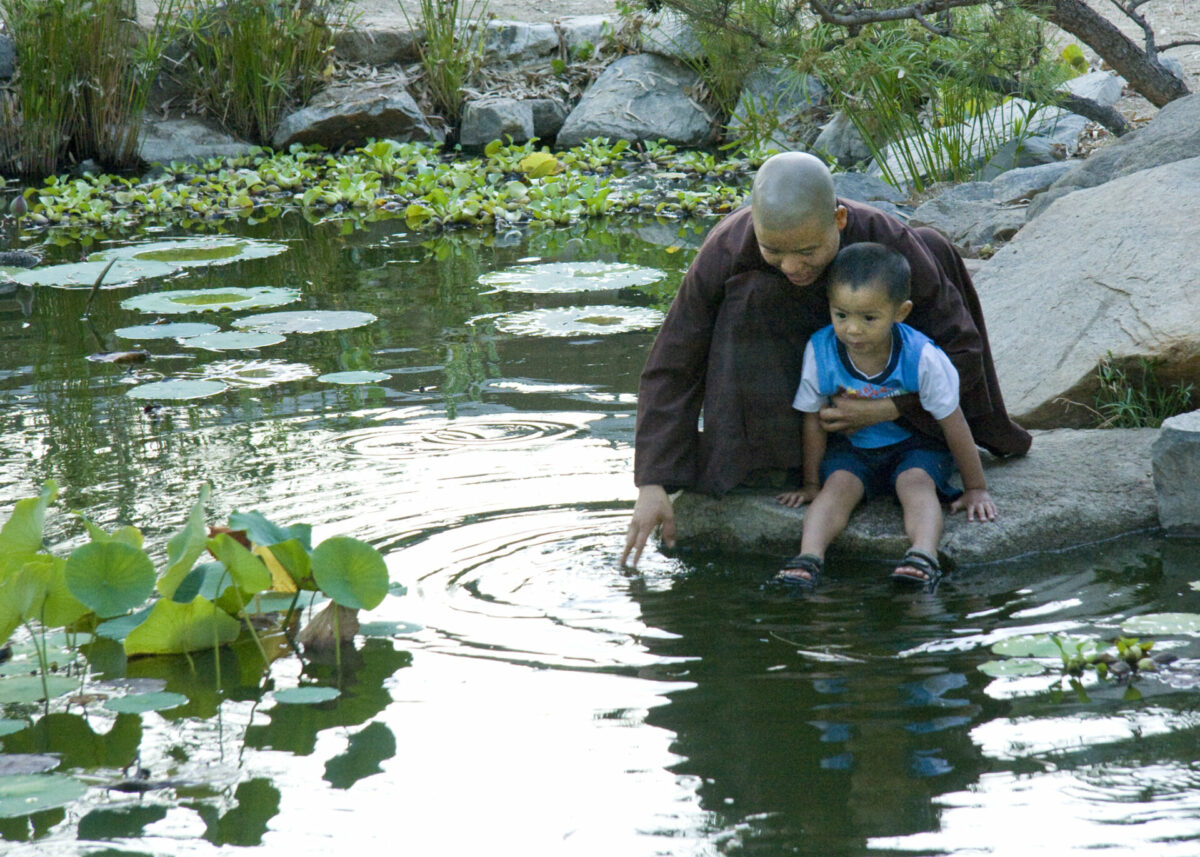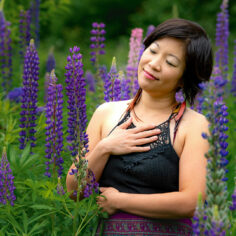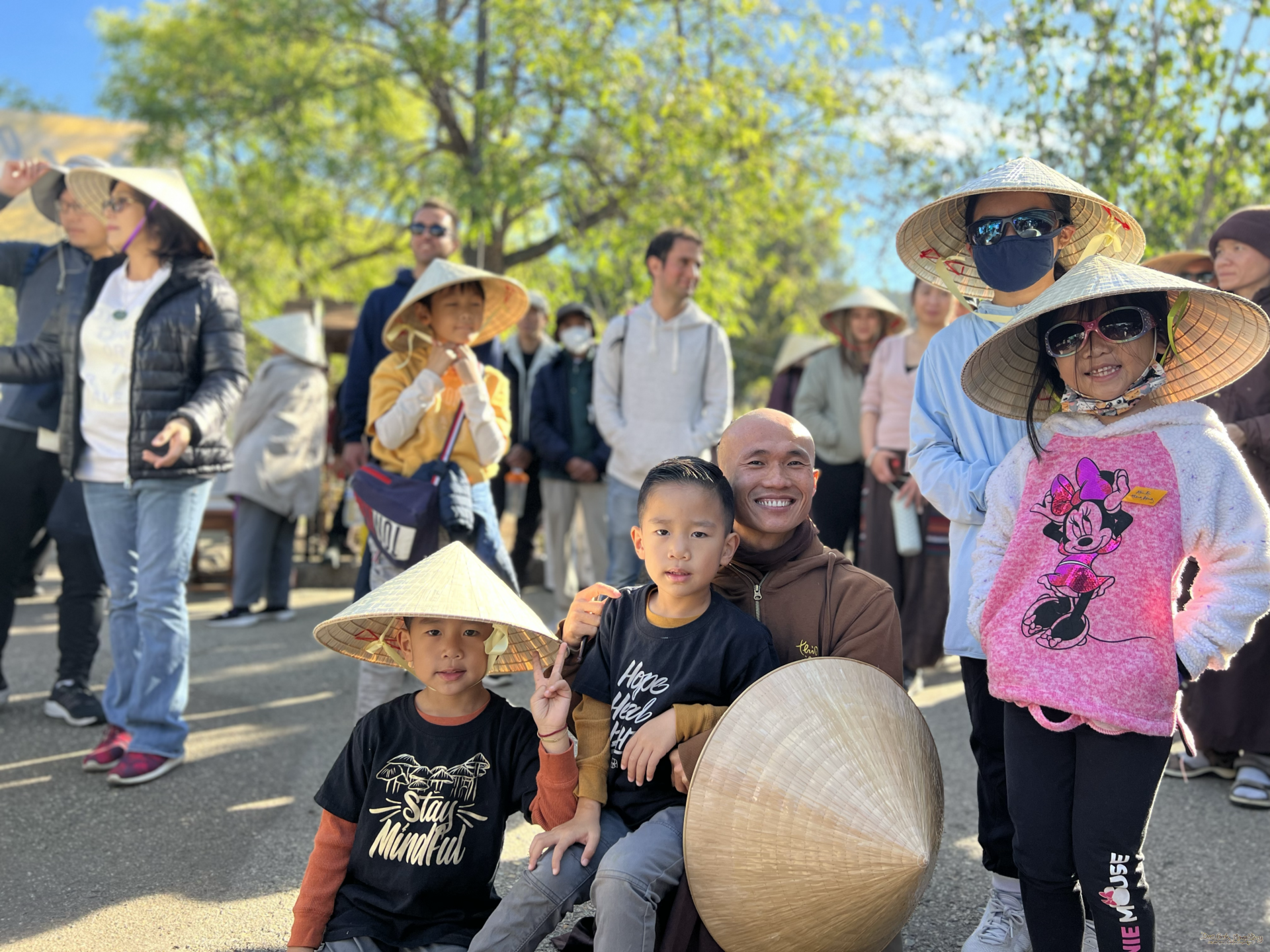By Reina Kato Lansigan on

photo by Ron Forster
I received the most precious gift when I, along with my supervisor and colleague Dr. Diane Gilbert-Diamond, attended The Buddha The Scientist Retreat and Symposium at Deer Park Monastery in September 2022. By the time we attended the retreat and symposium, Diane and I had had the honor of a two-year academic collaboration with Brother Pháp Lưu and lay members of the Plum Village community,
By Reina Kato Lansigan on

photo by Ron Forster
I received the most precious gift when I, along with my supervisor and colleague Dr. Diane Gilbert-Diamond, attended The Buddha The Scientist Retreat and Symposium at Deer Park Monastery in September 2022. By the time we attended the retreat and symposium, Diane and I had had the honor of a two-year academic collaboration with Brother Pháp Lưu and lay members of the Plum Village community, including Drs. Lilian Cheung and Orlaith (Orla) O’Sullivan. As mindfulness practitioners new to the Plum Village lineage of Buddhism, Diane and I were kindly invited to the retreat and symposium, where we presented our team’s research on mindfulness interventions for children. What ensued was a deep nourishment of our souls—and yes, transformation. Professional distance dissolved, and Diane transformed into my sister and an ally on a shared mission. Finding a sister in my colleague through this retreat was the most surprising and welcome gift.
I was struck by the sense that all the frustrations and pains I had experienced in life were worthwhile, since they led me to this point of unified Purpose: no mud, no lotus.
Since 2012, I have had the pleasure of helping advance Diane’s cutting-edge research on the influence of genetics and media on children’s responsiveness to food advertisements, overconsumption of junk foods, and obesity. At our behavioral research lab at the Geisel School of Medicine at Dartmouth, we have conducted randomized controlled trials with hundreds of children and families using genotyping, functional magnetic resonance imaging of the brain, eye-tracking technology, behavioral research paradigms, and a number of child and parent questionnaires. Our research has led to an important finding: some children are genetically more susceptible to the influence of food advertisements. Our lab has advocated for the protection of all children in the form of tighter regulations of child-targeted food advertisements. Our research has also informed future individualized obesity prevention and treatments that consider children’s genetic predisposition to be particularly reactive to food advertisements. Understanding the underlying mechanism of childhood obesity is critical to today’s society, in which one in three US children are overweight or obese.1 As a clinical social worker, former psychotherapist, and dancer for a contemporary dance theater company facilitating holistic healing and social change, however, I at times struggled to find a deeper connection to my work at the lab. As my own practice of mindfulness and somatics/dance continued to grow along with my personal suffering, I developed a yearning to immerse myself in mindfulness in my current work. So, when Diane asked me to be the project lead on developing a mindfulness intervention for children with Dr. Cheung at the Harvard T.H. Chan School of Public Health and members of the Plum Village community at the start of the COVID-19 pandemic in April 2020, I gratefully jumped at the opportunity.
I have a desire to devote my life to collective awakening. We mindfulness researchers are sowing seeds with our scientific evidence.
All of our ensuing work on cultivating mindfulness in children had been conducted remotely over Zoom and emails, necessitated by the pandemic as well as by our international collaborators. The Buddha The Scientist Retreat and Symposium afforded Brother Pháp Lưu, Diane, and me a chance to share the same physical space for the first time. Meeting many other inspired monastics and retreatants at Deer Park was powerful. When I learned that Diane was interested in shifting more of our lab’s focus to mindfulness interventions for children’s overall wellbeing, my personal and professional missions converged into one. I was struck by the sense that all the frustrations and pains I had experienced in life were worthwhile, since they led me to this point of unified Purpose: no mud, no lotus. My job has now transformed into the work I have been yearning for.
I have a desire to devote my life to collective awakening. And time is of the essence; a critical mass of awakened beings is urgently needed to turn the ship around and prevent further mass extinctions, climate disasters, violence, oppression, and injustice. Simply coalescing as activists fails to create lasting positive changes; the temptation to succumb to extremism, sectarianism, and despair when faced with seemingly insurmountable obstacles is simply too great. In this context, the balanced approach of mindfulness can foster collaborative solutions to complex issues while offering an antidote to divisiveness and despondence. Those who are already on the path of mindfulness intuitively know that it is The Way. We all innately want to suffer less and to live with more love and joy. Mindfulness brings moment-to-moment heightened awareness, appreciation of the divine in every being and object, and allows us to embrace pleasure and pain to their fullest depths without being defined by them. There are many skeptics, however, who have yet to be touched by the power of the practice. I see conducting rigorous scientific research on the efficacy of mindfulness practice as a means to entice some of those skeptics to dip their toes into the vast waters of mindfulness. We mindfulness researchers are sowing seeds with our scientific evidence. I am immensely grateful to have an ally and mentor in Diane, for the inspiring teachers, collaborators, and friends I have found in Brother Pháp Lưu and Drs. Cheung and O’Sullivan, and for the wonderful supporters in the Plum Village Sangha.
Mindfulness is a gift that keeps on giving. The more we practice, the more we give to ourselves and help others get into energetic alignment, often without even trying. On the day I returned from the retreat and symposium at Deer Park, I found one of my teenage daughters engrossed in Eckhart Tolle’s book, The Power of Now.2 I never prompted her to read this brilliant book, but there she was, holding in her hands a big hardcover copy borrowed from the local library. The day after I returned from the retreat, I discovered that my other daughter had joined a Sangha at her college and was diving into meditation for the first time, also completely on her own terms. Additionally, she joyfully reported that her randomly-assigned academic advisor is a sweet, older history professor who also happens to be a Zen monk. My friends have signed up for meditation retreats for the first time at Deer Park and elsewhere, and new and exciting mindfulness research projects have sprung from the connections forged at The Buddha The Scientist Retreat and Symposium. The ripple effects of mindfulness continue to spread in my personal and professional lives, for which I am truly grateful. Let’s walk, friends, hand-in-hand on the path of mindfulness, and bring new friends along. The more the merrier!
1 Kumar S, Kelly AS. Review of Childhood Obesity: From Epidemiology, Etiology, and Comorbidities to Clinical Assessment and Treatment. Mayo Clin Proc. 2017 Feb;92(2):251-265. doi: 10.1016/j.mayocp.2016.09.017. Epub 2017 Jan 5. PMID: 28065514.
2 Tolle, E. (2004). The Power of Now. New World Library.


